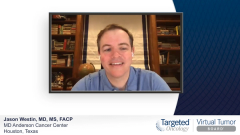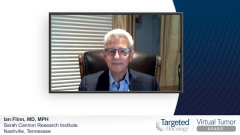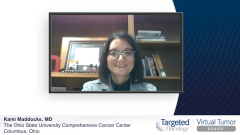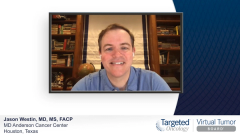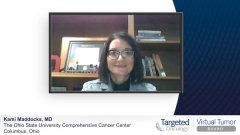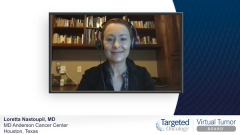
Case 3: Pivotal Trials for DLBCL
Jason Westin, MD, MS, FACP: Let’s now review the pivotal study that got polatuzumab FDA approved for a patient such as this. This is a phase 2 study that had the lead in of polatuzumab, bendamustine, rituximab. And then the randomized phase 2 portion was a 1:1 randomization of patients to receive [bendamustine, rituximab], or [bendamustine, rituximab] with polatuzumab. It was a 40-patient per arm study, and the outcomes are shown on our screen with an objective response rate clearly favoring polatuzumab, bendamustine, rituximab, more than doubling the overall response rate at 45%, with 40% of patients achieving a complete response. This is an impressive benefit for adding in the antibody-drug conjugate polatuzumab. For those who aren’t familiar with this drug, it is targeting a B-cell surface marker called CD79B, part of the B-cell receptor, which is nearly ubiquitously expressed on patients with large B-cell lymphoma.
The response rates here are impressive favoring the experimental arm of polatuzumab, bendamustine. You’ll also note that the duration of response is favoring, 7 months versus 12 months. And when we look at progression-free survival both by the central review and by the investigator, we don’t need a P value to see this difference is favoring the addition of polatuzumab.
We’re not going to review all the data on this drug today, but if we look back at the trial of Rituxan, polatuzumab, the one that was comparing it versus another antibody-drug conjugate that didn’t advance, pinatuzumab, the outcomes in that study look similar to me without bendamustine. Similar to this trial in the sense that the [polatuzumab, bendamustine, rituximab] arm looks about the same as the [polatuzumab, rituximab] arm. I’m not sure how much bendamustine adds here. In my practice I don’t tend to use much bendamustine for patients with large cell. It may be a toxic placebo.
There was a trial done in Japan a few years ago looking at [bendamustine, rituximab] for patients with relapsed large-cell lymphoma. And those patients who relapsed within 12 months didn’t respond to bendamustine. All of the responders were late relapses after primary therapy.
In this trial, the overall survival clearly favors polatuzumab, bendamustine, with nearly a year for median overall survival versus effectively the first or second restaged for the overall survival, 4 months for the bendamustine arm.
Looking at the forest plot, there’s not much to call out here other than there’s no group that does better with [bendamustine, rituximab]. Across the board, everybody benefited from the addition of polatuzumab, regardless of what variable you wanted to look at, this was favorable.
When we look at the toxicity, it’s not surprising, neutropenia is more common when we add an extra agent. The antibody-drug conjugates we know do have the tendency, even though it is a targeted chemotherapy, to have some off-target effects and have the cytopenias with the greater incidence of grade 3/4 neutropenia.
And similar to other antibody-drug conjugates such as brentuximab, the peripheral neuropathy is more seen in the polatuzumab group although it’s limited grade, grade 1/2 and in 40% of patients. No severe neuropathy was noticed on this clinical trial.
Another interesting agent that has been FDA approved, again in 2020, just like tafasitamab, lenalidomide, is selinexor. Selinexor is a novel drug that targets the nuclear export protein, effectively trapping tumor suppressors within the nucleus. Cancer cells often use that as a mechanism to avoid tumor suppression or death by ejecting these proteins from the nucleus, and therefore theoretically could have an increased toxicity against cancer cells over normal healthy cells.
The trial that allowed this drug to be approved was SADAL, which was a phase 2 single-arm study. And the eligibility here, something I want to highlight, is a little bit different than what we see in everyday practice. Patients who went on to this trial had to have at least a PR [partial response] to their most recent therapy. Or, if they did not achieve a PR or CR [complete response], they had to be without therapy for more than 14 weeks, or 3-1/2 months, which is a little bit different than what we see in our typical practice; patients who relapse or are refractory often need to have therapy relatively soon.
There were multiple dosing schedules looked at on this trial, and the higher the dose, the more frequent the drug, the more toxic it was. The group that was analyzed for the manuscript mentioned on the slide, published in The Lancet Haematology, was focused on this group that received 60 mg twice weekly, days 1 and 3, for a 4-week cycle. The primary end point in this trial was overall response, which found an overall response rate of 28% and a CR rate of 12 %. There was a slightly higher response in the GCB [germinal center B-cell] subtype, 34% versus 21% in the non-GCB subtype, although this was not a powered analysis. It’s unclear what this means, if this will hold up in more patients in the future.
Looking at the waterfall plot, we see that the majority of patients did have some degree of tumor suppression, but not all. This was a study where not every patient received benefit, and not every patient was able to stay on this drug for a long period due to some toxicities.
Similar to the polatuzumab study, the forest plot here favors the use of this drug in every patient. There wasn’t one particular group that jumped out as, this is the ideal candidate, or this is the subtype, or this is the scenario you would use this in. It worked in patients across the spectrum relatively evenly without anything that I would call out as a highlight of a better response in a particular subgroup. I’ve alluded to a few times, the toxicities were not trivial, and if we look at the thrombocytopenia, the majority of patients had some degree of thrombocytopenia, with about half, 46%, having grade 3/4, and this often required dose hold or dose adjustment, sometimes requiring TPO [thrombopoietin] drugs to try and stimulate platelet recovery.
Nausea, fatigue, anorexia were other concerns that were seen on this study, which could generally be managed, but were not trivial. And 17% of patients required stopping therapy because of toxicities.
Transcript edited for clarity.


